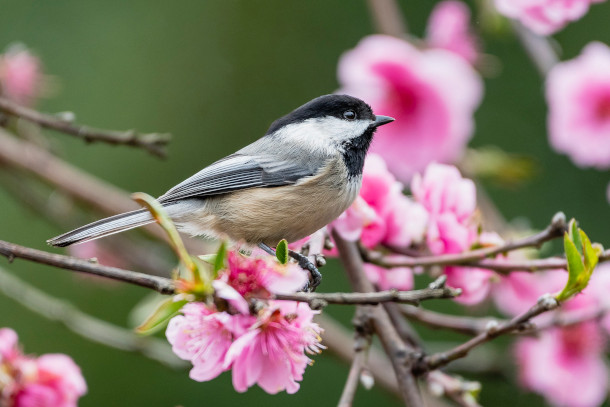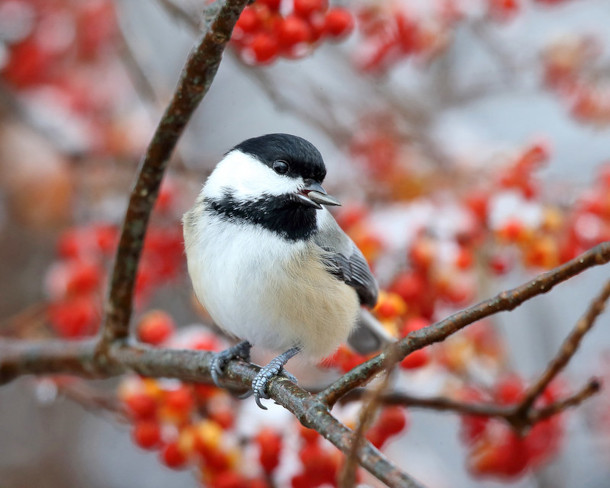BIRIDNOTE®: Bird Habitat at Home
Air Date: Week of July 28, 2023

A black-capped chickadee perches on a tree branch. (Photo: Colin Durfee, CC)
Cultivating natural habitat for native birds can help combat biodiversity loss, as Ariana Remmel reports in today’s BirdNote.
Transcript
CURWOOD: It’s Living on Earth, I’m Steve Curwood.
O’NEILL: And I’m Aynsley O’Neill.
[BIRDNOTE THEME]
O’NEILL: One way to help combat biodiversity loss in your own backyard is to cultivate the kind of natural habitat that backyard feeder birds can make into a home. BirdNote’s Ariana Remmel has the story.
BirdNote®
Creating Bird Habitat at Home
One of the biggest threats to birds is the decline in biodiversity due to habitat loss — and the traditional, manicured lawn isn’t helping.
[Black-capped Chickadee call, ML 202239]
Even birds who visit backyard feeders — like these Black-capped Chickadees — need a healthy mix of seeds, berries, and insects often found on the native plants we villainize as “weeds” when they grow in our lawns, says ecologist Douglas Tallamy.
Doug Tallamy: We have more than 40 million acres of lawn in the US, which is the size of New England. And that's an ecological deadscape.
[Deciduous Forest Morning Songbirds]
That means one of the easiest ways to protect birds at home is to grow native plants, says Tallamy, who co-founded an organization called Homegrown National Park® to help people transform their lawns into havens for wildlife.
Doug Tallamy: And I’d love people to stop looking at their yard as an isolated ecosystem, it's part of a neighborhood. And somebody who's got a sunny spot down the street, but no trees? Okay, that's where the pollinator gardens go. Somebody who's got a giant oak and is overspreading two or three yards? That's great! That's going to provide a lot of resources for many of the houses in that yard. So look at your neighborhood as an entire local ecosystem and see what the total resources are.

A black-capped chickadee bites down on a seed. (Photo: Tom Murray, CC)
Reducing your lawn to make room for native plants is a small step forward —
Doug Tallamy: But imagine if everybody did this. This is why we call the Homegrown National Park® movement a grassroots movement, it's a call to action.
To learn more about Homegrown National Park®, start at our website: BirdNote dot org.
[Black-capped Chickadee call, ML 202239]
###
Written by Ariana Remmel
Senior Producer: John Kessler
Content Director: Allison Wilson
Producer: Mark Bramhill
Managing Producer: Conor Gearin
Bird sounds provided by The Macaulay Library of Natural Sounds at the Cornell Lab of Ornithology, Ithaca, New York. Black-capped Chickadee ML 202239 recorded by J. McGowan. Morning Songbirds recorded by Gordon Hempton.
BirdNote’s theme was composed and played by Nancy Rumbel and John Kessler.
© 2022 BirdNote March 2022 Narrator: Ariana Remmel
ID # hnp-01-2022-03-21 hnp-01
https://www.birdnote.org/listen/shows/creating-bird-habitat-home
Links
Living on Earth wants to hear from you!
Living on Earth
62 Calef Highway, Suite 212
Lee, NH 03861
Telephone: 617-287-4121
E-mail: comments@loe.org
Newsletter [Click here]
Donate to Living on Earth!
Living on Earth is an independent media program and relies entirely on contributions from listeners and institutions supporting public service. Please donate now to preserve an independent environmental voice.
NewsletterLiving on Earth offers a weekly delivery of the show's rundown to your mailbox. Sign up for our newsletter today!
 Sailors For The Sea: Be the change you want to sea.
Sailors For The Sea: Be the change you want to sea.
 The Grantham Foundation for the Protection of the Environment: Committed to protecting and improving the health of the global environment.
The Grantham Foundation for the Protection of the Environment: Committed to protecting and improving the health of the global environment.
 Contribute to Living on Earth and receive, as our gift to you, an archival print of one of Mark Seth Lender's extraordinary wildlife photographs. Follow the link to see Mark's current collection of photographs.
Contribute to Living on Earth and receive, as our gift to you, an archival print of one of Mark Seth Lender's extraordinary wildlife photographs. Follow the link to see Mark's current collection of photographs.
 Buy a signed copy of Mark Seth Lender's book Smeagull the Seagull & support Living on Earth
Buy a signed copy of Mark Seth Lender's book Smeagull the Seagull & support Living on Earth

